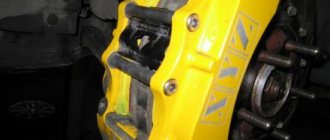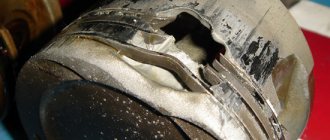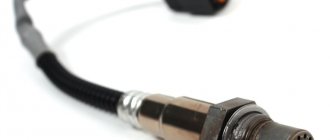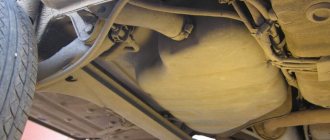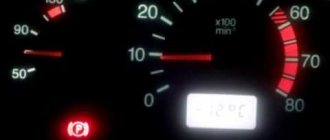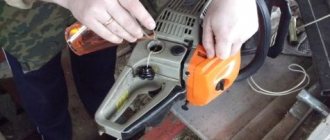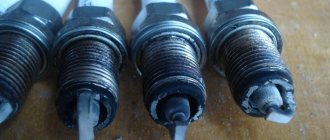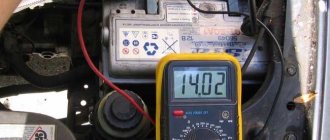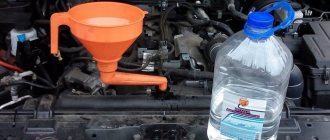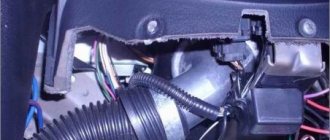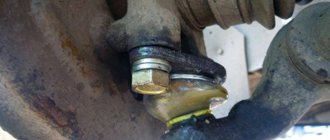A fairly common car malfunction is vibration of the steering wheel at a speed of 90-100 km per hour. At low speed everything may be fine. But as it increases, the steering wheel begins to “come to life” in your hands. And even when driving on a flat road. It often happens that this phenomenon appears gradually, from a small, barely noticeable vibration to real trembling, when not only the steering wheel, but also the column shakes. Following this, the instrument panel and interior trim rattle so much that it becomes impossible to drive. It is worth noting that this problem appears not only on domestic cars, but also on many foreign cars. Commercial vehicles, for example, Gazelle, are no exception. When steering wheel vibration appears at a speed of 90-100, the main reasons can be very different. So let's look at them in detail.
Incorrect balancing
Poorly balanced wheels are the main reason why the steering wheel vibrates at speeds of 90-100 km/h.
Dirt or icy snow may stick to the disc, often on the inner side, invisible to the eye. At low speeds, this additional load does not manifest itself in any way. But as it increases, the centrifugal force from the center of the wheel also increases. The imbalance will be significant, so the wheel begins to jerk, causing vibration to reverberate through the steering wheel. This malfunction can be eliminated by simply cleaning the wheel disk from the outside and inside.
Tire imbalance
The reason for this phenomenon may also be defects in the rubber itself as a result of hitting an obstacle or falling into a hole (often at high speed), which causes the carcass elements on the tire to deteriorate and it takes on an irregular shape. This defect is called a “hernia.” It is almost impossible to correct it, but you can try to correct it by balancing the wheel. But even in this case, the steering wheel will vibrate at speeds of 90-100. What to do in this situation? Such a tire will still no longer work as it should, and it will soon have to be changed.
Incorrect wheel alignment angles
The front wheels of the car are not parallel to each other. This is done to compensate for uneven wear under and without load. If the installation angles are incorrect, the rubber will “eat up”, which can also lead to vibration.
This is especially evident when one wheel is not aligned properly. In such situations, the vibration of the steering wheel at a speed of 90-100 km/h is especially noticeable. It is simply impossible to drive such a car.
Wear or damage to suspension components
The wheel suspension includes many articulated elements, each of which has its own specific service life. These are oil seals, silent blocks, ball joints, bearings.
All of them operate within the permissible backlash, if exceeded, vibration of the steering wheel may occur at speeds of 90-100. There are a variety of ways to solve this problem: from diagnosing the chassis to troubleshooting the problem yourself. They are often complex and seriously damage the vehicle's chassis. Since the suspension is in constant motion, excess play (for example, a ball joint) leads to rapid loosening of the silent block of the lower suspension arm.
Diagnostics and standard causes of vibrations
VAZ 2110 vibration on the steering wheel
There may be several reasons why vibrations are observed on the steering wheel of a VAZ 2110 car. In many cases, a superficial diagnosis will not provide accurate answers, and only a competent, thorough examination will help determine an accurate diagnosis.
Brake pads
As a rule, new motorists who understand little about cars naively believe that shaking and vibration are the result of worn brake pads. Having installed new brake pads, motorists begin to understand that the reasons lie much deeper. Although, if this “disease” has not gone too far, then changing the pads also helps, but for a while. And for the most part, replacing pads with new ones is a waste of time and effort.
Discs
As for the so-called “garage” specialists, they will all say the same thing - vibrations are associated with brake discs that need to be replaced with new ones. And it is imperative to install imported brake discs, since domestic ones do not cope well with their function. What's true is true. The runout of domestic brake discs installed on a car is much greater than even that of old discs installed on an assembly line. In addition, the metal of our discs is often “raw,” so to speak, that is, it is easily affected by the brake pads and wears off.
Note. Installing new brake discs does not completely guarantee that vibrations will disappear. The fact is that the reason may lie even deeper, and changing disks will only give half the effect.
Grooving brake discs
Grooving brake discs
Usually, when a car runs more than 50 thousand km, complaints about steering wheel shaking increase. The standard diagnostic option in service centers is as follows:
- The chassis of the car is carefully checked;
- The vehicle controls are subject to diagnostics;
- The left steering tip is often replaced;
- Wheels are being balanced;
- Brake discs are either replaced with new ones or sharpened.
The question arises: why buy new brake discs, especially ventilated ones (they are not cheap), if you can simply grind them, which gives excellent results.
Attention! It is noteworthy that sharpening brake discs is not so easy. This requires the skills of a highly qualified turner, who can identify by eye the excess part of the working surfaces, which he can successfully grind off. After this, the surfaces may remain rough, but there is no need to worry about this.
Attention! The minimum permissible thickness of a ventilated disc for a VAZ 2110 is 17.8 mm, and a non-ventilated one is 10.8 mm.
Non-standard reasons
It’s interesting, but it also happens that after sharpening and installing the discs, the vibrations on the steering wheel do not disappear. In this case, an unconventional method can help - turning the hub itself on a lathe, which reduces runout.
Algorithm for grooving the hub
- A special device is attached rigidly and at the desired angle (necessarily strictly perpendicular to the plane of rotation);
- Powerful supports are placed under the car;
- The jack is removed, and the brake caliper is tied firmly to the shock absorber strut.
Note. You need to tie the brake caliper with wire and away from the lathe.
- We start the engine;
- We turn on fourth gear;
- We connect the “machine”.
Note. The chips should be thinly wound around the cutter. After one full pass, the remaining portion will be visibly visible on the hub. After the next few visits, this very “bald patch” will completely disappear.
- The hub is ground to zero.
The grenade fell apart
On a VAZ 2110, the causes of vibration in the steering wheel may be associated with a grenade, although some would-be masters deny this. Features of steering wheel vibration when a grenade is scattered:
- When accelerating, vibrations are clearly felt;
- You feel them and disappear when you coast;
- In the early stages, steering wheel vibration can be felt at speeds of 60-80 km/h;
- At low speeds vibrations are not felt;
- The car may run off the road in the later stages of this disease, especially at speeds above 100 km/h;
- In addition to the vibrations, you also feel a terrible knocking sound, and when you release the gas pedal, the vibration immediately disappears;
- Vibrations can clearly increase in proportion to the number of people in the cabin (the more people there are, the stronger the vibration);
- A strong frontal wind can also cause an increase in vibrations.
If you observe the above symptoms, you need to inspect the grenade. It is noteworthy that a CV joint defect may not be immediately noticed. You'll have to tinker a little, take the shafts with grenades in your hands and twist them, changing the angle.
Wheel balancing is the most common cause of vibration in the steering wheel.
Steering wheel VAZ 2110
As you know, balancing the wheels of a car plays a vital role in driving a vehicle. It can be damaged by any little thing or foreign objects that get into the wheel tread.
Note. Experts advise checking the balancing every 5 thousand km of the car.
It is worth noting that there are no perfectly balanced wheels. It is customary to recognize each wheel as having its own heavy section, which, when spinning and gaining speed, prevents the car from driving normally. If the balancing is incorrect, the car begins to bounce and sway on the road, and vibrations are felt in the steering wheel.
Steering wheel vibration due to improper wheel balancing
Symptoms of vibration on the steering wheel due to improper balancing
- Vibrations usually appear when driving in a straight line at speeds above 100 km/h;
- Vibrations can also be felt when turning the steering wheel;
- They are also noticeable when accelerating or braking the vehicle;
- The steering wheel also vibrates when the car is idling.
Balancing should always be carried out in services where there is special equipment for this. The usual procedure is as follows:
- The wheel is washed and cleaned;
- Then they are installed on a special balancing stand;
- After this, the location of installing the additional load on the wheel disk is determined;
- The wheel is then mounted on a special type of adapter;
- Balancing is carried out again, since the fixing cone of the wheel during operation could be subjected to various mechanical damages.
As for the final balancing, it can be carried out without removing the wheels:
- The vehicle is supported using a jack;
- The wheels are then accelerated to the equivalent of driving at 120 km/h.
Final balancing is considered the most accurate and is usually carried out at the end. Of course, you won’t be able to do the balancing yourself, but you can still determine the cause of the steering wheel vibrations yourself. It will also be useful to view many photos, including those carried out here, and videos. Detailed instructions that provide ways to replace various parts, such as discs or pads, will also be very relevant. In any case, the price of the repair that you can do yourself will be several times lower than the operation that will be done at a service station.
Wheel bearing wear
This element ensures smooth rotation of the wheel on the axle. Its long-term operation is ensured by the correct tightening torque, at which it should rotate freely, but without play. An undertightened bearing, like an overtightened one, quickly wears out and begins to jam. This is quite easy to check. With the wheel removed, you need to release the pads and turn the brake disc by hand. If, when the latter rotates, the resistance to rotation increases from time to time and an extraneous sound appears, it means that the bearing is jammed. It should also disappear when the nut holding the bearing is slightly loosened. It won't last long in this condition.
Cardan shaft as a cause of increased vibration
Sometimes it happens that in cars with all-wheel drive or rear-wheel drive, steering wheel vibration appears at speeds of 90-100. The main problems here are related to the driveshaft. It must be balanced, just like the wheels.
When the car is moving, the driveshaft rotates faster than the wheels. Therefore, its imbalance is felt much more strongly. In addition to the shaft itself, hinges can contribute to vibration. These are the cardan mechanism and the outboard bearing (shaft support). The unit itself can be balanced. And individual hinges will most likely need to be replaced.
Steering wheel wobble at low speed and at idle
Also, difficulty with the occurrence of steering wheel vibration when turning right or left can be caused by insufficiently reliable fastening of the internal combustion engine to the car body. This leads to consequences such as:
- large feedback from the steering wheel at idle;
- vibration of the steering wheel when the car comes to a complete stop;
- deviations in the steering when starting the car;
- when squeezing the accelerator and increasing speed.
It is very simple to recognize the cause of such vibration in the steering wheel: a high-frequency beat occurs, the vibration completely depends on the number of engine revolutions. Consequently, as the speed increases using the gas pedal, the vibration becomes more frequent. The problem can also arise if the drive shaft is not operating correctly. However, this rarely happens.
Tire features
Steering wheel vibration at speeds of 90-100 km/h occurs due to the use of special, highly specialized tires. A striking example is tires for SUVs. These tires are soft, but the tread pattern elements are hard and large.
Off-road this gives amazing traction. But when driving at high speeds, this softness can lead to imbalance and vibration, as well as increased noise. Large holes when driving at speed with such tires are very dangerous.
What to do if the steering wheel shakes at low speeds or when braking?
A problem that has become widespread is that the steering wheel shakes at low speeds or when braking.
What is the problem with such an unpleasant phenomenon that makes the driver panic? Newbies panic, count money and wait for news from their auto mechanic. But is it worth worrying about this problem, is it possible to solve it yourself and how much will it cost if you contact a service center?
The steering wheel shakes at low speed, this is already in a critical situation, when a breakdown in the steering mechanism has already occurred. If you notice a similar phenomenon at low speed or when braking, then you should think about it. Continued use of the vehicle may result in even more expensive repairs.
Wheels do not comply with factory recommendations
A car rim has its own parameters - width, tire mounting diameter, offset, as well as the diameter of the drill, i.e. the circle on which holes are drilled for mounting bolts or studs. For each wheel model, the number of these holes and their diameter are indicated. If the disk parameters are incorrectly selected, the mount will not screw in completely and will not press the wheel tightly to the hub. As a result, the disk has play. If the diameter of the holes drilled does not match, the wheel will also not sit in its place. Of course, it can be planted using physical force. However, the plane of the disk will not coincide with the parameters of the hub. This is not good for the car.
Steering faults
Increased vibration of the steering wheel at speeds of 90-100 km/h can be caused not only by malfunctions of the suspension and wheels, but also by the control itself.
Broken tips, the steering mechanism itself and play in the universal joints of the column can also affect the appearance of vibration. This is also facilitated by worn support bearings of the steering column and the rack itself.
Although the reason may be trivial - loosening of the steering wheel fastening nut. The solution to the problem is to tighten the bolt.
Case from practice
A similar phenomenon began to be noticed by the owner of a Volkswagen Golf; extraneous vibrations appeared in the steering mechanism when the car was moving around 70 km/h
. If the speed was insignificant, vibrations disappeared; after accelerating the car over 100 km/h, they were also not observed.
Taking into account the quality of our roads (which is poor), and plus the vibrations and beatings that a faulty steering mechanism creates, driving such a car turned into torture. The steering wheel just almost jumped out of my hands.
Naturally, the most effective and simplest way is to take the car to a service station.
. But it’s good if you have a familiar auto mechanic who will do everything efficiently. And if not? Then few people will give you a guarantee that the car will be repaired quickly, and the money that will be taken from you will be comparable to repairs.
Yes, such a problem occurs quite often; auto mechanics constantly make money from such troubles, increasing the cost of repairs. They may also impose costs on you for unnecessary manipulations, for example, replacing the entire steering mechanism, because few people want to dig around and look for the real causes of the malfunction. To prevent this from happening, any car owner should at least roughly know the reasons for this behavior of the steering wheel.
Worn or warped brake discs
These elements are installed on the hub and are clamped by pads when the speed decreases. There is practically no gap between the disc and pads. Therefore, the surface of the assembly must be perfectly flat. The slightest distortion of the disc causes the steering wheel to vibrate at speeds of 90-100 km/h. Warping of brake elements most often occurs due to frequent and intense braking, as well as when driving through deep puddles. The heated disk bends due to sudden cooling. This element cannot be repaired - only replaced.
Ways to solve the problem
Whatever the reasons for the steering wheel beating, it is necessary to carry out high-quality diagnostics and eliminate the problems. This will make it possible to avoid expensive repairs, and most importantly, prevent accidents!
If the steering wheel shakes at low speed, proceed as follows:
- check the cleanliness of the wheel rims;
- check the balancing and fastening of bolts on the wheels;
- test discs for deformation;
- check the quality of rubber;
- diagnose the suspension;
- examine brake discs and drums;
- check the engine mounting;
- try the quality of the drive shaft.
Wheel rims are easier and faster to clean at a car wash. A stream of water will remove accumulated dirt. Hit the disc with some object, reducing the amplitude of vibrations of the steering wheel, in order to safely drive to the car wash or service station.
Have your balancing done at a tire shop. Balance all 4 wheels, especially if the steering wheel shakes at low speeds. At the same time, eliminate the deformation of the wheel rims and give them their initial shape on a straightening machine.
Replace defective tires. It will not be possible to restore it - you will have to buy new tires and mount them according to the canons of proper balancing.
Steering wheel wobble at speed due to a faulty suspension or steering mechanism is “treated” by disassembling the chassis, inspecting the parts and fixing the problem. More often than others, grenades (CV joints), rubber-metal joints, and steering bushings break.
The beating that occurs during braking can be eliminated at a service station. The machine grinds and restores the surface of the brake discs if the degree of wear is low.
It is better not to fix steering wheel wobble at speed yourself. Only car services will accurately determine the cause of the breakdown and eliminate it. Most workshops work with specific brands of cars; they have a better understanding of the specifics of the models, know the characteristic “sores” and are able to quickly recognize them.
